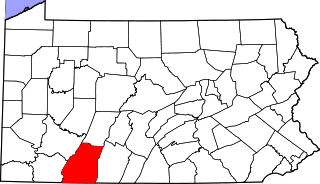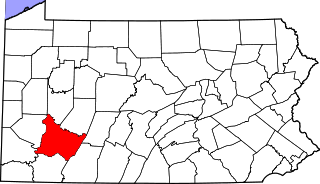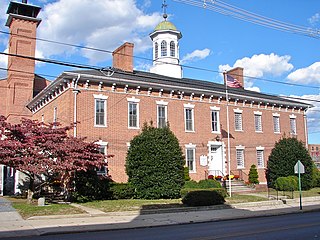
Greene Township is a township in Greene County, Pennsylvania, United States. The population was 399 at the 2020 census.

The Mother Bethel African Methodist Episcopal Church is an historic church and congregation which is located at 419 South 6th Street in Center City Philadelphia, Pennsylvania, USA. The congregation, founded in 1794, is the oldest African Methodist Episcopal congregation in the nation.

The Dobbin House Tavern, known also as Dobbin House, on 89 Steinwehr Avenue in Gettysburg, Pennsylvania is a tavern which is listed on the National Register of Historic Places.

The F. Julius LeMoyne House is a historic house museum at 49 East Maiden Street in Washington, Pennsylvania. Built in 1812, it was the home of Dr. Francis Julius LeMoyne (1798–1897), an antislavery activist who used it as a stop on the Underground Railroad. LeMoyne also assisted in the education of freed slaves after the American Civil War, founding the historically black LeMoyne–Owen College in Memphis, Tennessee. His house, now operated as a museum by the local historical society, was designated a National Historic Landmark in 1997. It is designated as a historic public landmark by the Washington County History & Landmarks Foundation.

The Glebe House, built in 1854–1857, is a historic house with an octagon-shaped wing in Arlington County, Virginia. The Northern Virginia Conservation Trust holds a conservation easement to help protect and preserve it. The name of the house comes from the property's history as a glebe, an area of land within an ecclesiastical parish used to support a parish priest. In this case, the glebe was established by the Church of England before the American Revolutionary War.

The Corbly Family massacre refers to the massacre of members of the family of the Rev. John Corbly by Indians on May 10, 1782.

This is a list of the National Register of Historic Places listings in Greene County, Pennsylvania.

This is a list of the National Register of Historic Places listings in Somerset County, Pennsylvania.

This is a list of the National Register of Historic Places listings in Westmoreland County, Pennsylvania.

Bethel A.M.E. Church, now known as the Central Pennsylvania African American Museum, is a historic African Methodist Episcopal church at 119 North 10th Street in Reading, Berks County, Pennsylvania. It was originally built in 1837, and is a 2½-storey brick and stucco building with a gable roof. It was rebuilt about 1867–1869, and remodeled in 1889. It features a three-storey brick tower with a pyramidal roof topped by a finial. The church is known to have housed fugitive slaves and the congregation was active in the Underground Railroad. The church is now home to a museum dedicated to the history of African Americans in Central Pennsylvania.

The Chads House, which was built by John Wyeth Jr. for John Chads, is located in Chadds Ford, Delaware County, Pennsylvania. The house was built after 1712 and was added to the National Register of Historic Places on March 11, 1971. John Chad's widow, Elizabeth, stayed in the house while it was in the line of fire during the Battle of Brandywine. The city of Chadds Ford relied on the spring ford on the property, and thus the city was named after John Chads.

Fort Hunter Historic District is a national historic district located at Fort Hunter, Dauphin County, Pennsylvania. The district includes six contributing buildings, four contributing sites, and one contributing structure. The area has seen continuous settlement since the early 1700s and once was the site of an early supply fort and garrison. Also in the district are the remains of a section of the Pennsylvania Canal. Notable buildings include the separately listed Archibald McAllister House, a spring house, Everhart Covered Bridge, large frame barn (1876), corn crib, farm house, blacksmith shop, stone stable barn, Hunter's House or Old Hotel, ice house, and archaeological sites for Fort Hunter, the garrison, Hunter's Mill, and the Pennsylvania Canal.

The Old Franklin County Jail is a historic jail located at Chambersburg in Franklin County, Pennsylvania. It was built in 1818, and is a two-story, brick building with a slate covered hipped roof topped by a cupola. The original building measures 84 feet wide by 48 feet deep. In 1880, a cell block was added. The jail yard is divided into two sections and surrounded by a 20-foot-high wall. At least seven prisoners were hanged on the premises.

The Greene Academy, now known as the Greene Academy of Art, is an historic school building which is located in Carmichaels in Greene County, Pennsylvania. It is a two-and-one-half-story stone and brick building with a gable roof.

The Greene Hills Farm, also known as the Greene County Historical Society Museum, is an historic home which is located in Franklin Township in Greene County, Pennsylvania.

Lancaster County Courthouse is a historic courthouse building located at Lancaster, Lancaster County, Pennsylvania. The original building was built between 1852 and 1855. The original building was designed by Philadelphia architect Samuel Sloan (1815–1884). The north wing was added between 1896 and 1898, and low flanking wings on either side of the exterior staircase were added in 1926–1927. These later additions were designed by Lancaster architects James H. Warner and C. Emlen Urban, respectively. It is an important example of the Romanesque Revival style.
Stewartstown is an unincorporated community in Monongalia County, West Virginia, United States.

John Brown Farm, Tannery & Museum, 17620 John Brown Rd., Guys Mills, PA 16327, is a historic archaeological site located in Richmond Township, Crawford County, Pennsylvania. The tannery was built in 1825 by famed abolitionist John Brown (1800–1859), who lived on the site from 1825 to 1835. The tannery was about 0.25 miles (0.40 km) from the new Pennsylvania and Ohio Canal.

Henry Fisher House is a historic home located in Oley Township, Berks County, Pennsylvania. It was built between 1798 and 1801, and is a 2+1⁄2-story, five bay by two bay, limestone dwelling with a steeply pitched gable roof. It has a two-story, rear kitchen addition with a flat roof. The main house has a Georgian center hall plan. The Fisher family has lived in the house since it was completed.

Reading Furnace Historic District is a national historic district located in Warwick Township and East Nantmeal Township, Chester County, Pennsylvania.























